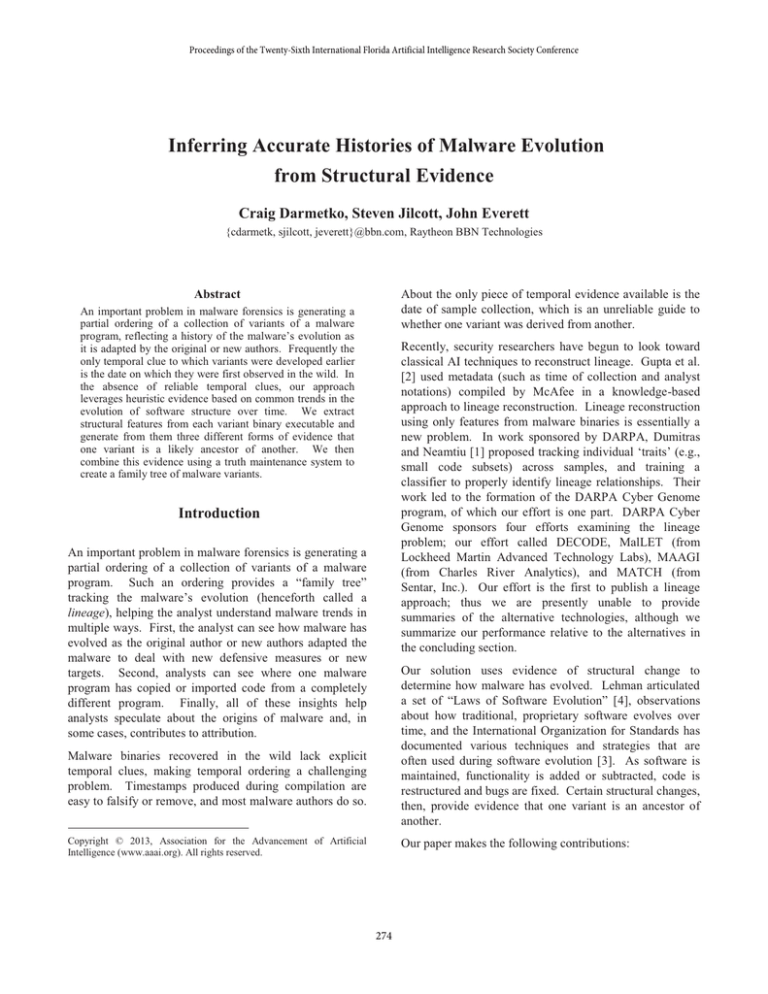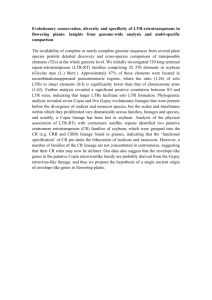
Proceedings of the Twenty-Sixth International Florida Artificial Intelligence Research Society Conference
Inferring Accurate Histories of Malware Evolution
from Structural Evidence
Craig Darmetko, Steven Jilcott, John Everett
{cdarmetk, sjilcott, jeverett}@bbn.com, Raytheon BBN Technologies
About the only piece of temporal evidence available is the
date of sample collection, which is an unreliable guide to
whether one variant was derived from another.
Abstract
An important problem in malware forensics is generating a
partial ordering of a collection of variants of a malware
program, reflecting a history of the malware’s evolution as
it is adapted by the original or new authors. Frequently the
only temporal clue to which variants were developed earlier
is the date on which they were first observed in the wild. In
the absence of reliable temporal clues, our approach
leverages heuristic evidence based on common trends in the
evolution of software structure over time. We extract
structural features from each variant binary executable and
generate from them three different forms of evidence that
one variant is a likely ancestor of another. We then
combine this evidence using a truth maintenance system to
create a family tree of malware variants.
Recently, security researchers have begun to look toward
classical AI techniques to reconstruct lineage. Gupta et al.
[2] used metadata (such as time of collection and analyst
notations) compiled by McAfee in a knowledge-based
approach to lineage reconstruction. Lineage reconstruction
using only features from malware binaries is essentially a
new problem. In work sponsored by DARPA, Dumitras
and Neamtiu [1] proposed tracking individual ‘traits’ (e.g.,
small code subsets) across samples, and training a
classifier to properly identify lineage relationships. Their
work led to the formation of the DARPA Cyber Genome
program, of which our effort is one part. DARPA Cyber
Genome sponsors four efforts examining the lineage
problem; our effort called DECODE, MalLET (from
Lockheed Martin Advanced Technology Labs), MAAGI
(from Charles River Analytics), and MATCH (from
Sentar, Inc.). Our effort is the first to publish a lineage
approach; thus we are presently unable to provide
summaries of the alternative technologies, although we
summarize our performance relative to the alternatives in
the concluding section.
Introduction
An important problem in malware forensics is generating a
partial ordering of a collection of variants of a malware
program. Such an ordering provides a “family tree”
tracking the malware’s evolution (henceforth called a
lineage), helping the analyst understand malware trends in
multiple ways. First, the analyst can see how malware has
evolved as the original author or new authors adapted the
malware to deal with new defensive measures or new
targets. Second, analysts can see where one malware
program has copied or imported code from a completely
different program. Finally, all of these insights help
analysts speculate about the origins of malware and, in
some cases, contributes to attribution.
Our solution uses evidence of structural change to
determine how malware has evolved. Lehman articulated
a set of “Laws of Software Evolution” [4], observations
about how traditional, proprietary software evolves over
time, and the International Organization for Standards has
documented various techniques and strategies that are
often used during software evolution [3]. As software is
maintained, functionality is added or subtracted, code is
restructured and bugs are fixed. Certain structural changes,
then, provide evidence that one variant is an ancestor of
another.
Malware binaries recovered in the wild lack explicit
temporal clues, making temporal ordering a challenging
problem. Timestamps produced during compilation are
easy to falsify or remove, and most malware authors do so.
Copyright © 2013, Association for the Advancement of Artificial
Intelligence (www.aaai.org). All rights reserved.
Our paper makes the following contributions:
274
x
We describe how we extract and represent three
types of structural change evidence from malware
binaries.
x
We present an approach for combining evidence
using a truth maintenance system, and deduce a
lineage from a collection of samples.
x
We evaluate our approach on a set of malware
lineages provided by another organization for use
in Cyber Genome for which precise ground truth
lineage was known.
Difficult to fake or obfuscate
x
Increases the likelihood that one sample is an ancestor
of another
For example, different compiler versions or the use of x86
instructions from newer instruction sets satisfies
characteristics 2 and 3, but these examples do not satisfy 1
due to their scarcity of appearance. Similarly, timestamps
in the binary satisfy 1 and 3, but can be easily faked and
thus do not satisfy characteristic 2.
We compute three types of evidence from structural
features: functional point complexity, similarity of string
data, code subsets. Each type of evidence provides a
likelihood that some samples are ancestors of other
samples.
We first overview the process of extracting structural
information from binary executables, identifying evidence
of structural change, and then reconstructing a lineage
based on that evidence.
We then give a detailed
description of each of the three types of lineage evidence.
Next we describe our use of the Jess rule engine
(http://herzberg.ca.sandia.gov/) to implement a truth
maintenance system and generate a lineage. We conclude
with an evaluation of our approach on several sets of
malware variants and summarize our performance relative
to the alternative approaches in Cyber Genome.
We insert ancestry evidence into a truth maintenance
system (TMS) built on top of the Jess rule engine. We
propagate the evidence in the TMS to determine the most
likely of three relationships for each pair of samples:
ancestor, descendant, or unrelated. We then extract from
the final Jess state a lineage graph with the maximum
likelihood.
Overview
Extracting Lineage Evidence
A lineage is a partial ordering of malware samples, and can
be represented as a graph where each vertex represents a
sample, and a directed edge connects a sample to another
sample immediately derived from it. We assume that the
lineage is connected; each sample in the set is the source of
or is derived from at least one other sample in the set.
Given the structural change heuristics we describe below,
it is sufficient if each sample shares a majority of its code
with at least one other sample.
Functional Point Complexity
One of the observations in the so-called “Lehman’s Laws
of Software Evolution” [4] is that unless refactored,
software will increase in complexity over time. We
compute the complexity of a malware sample using a
Functional Point Complexity metric adapted from [7]. The
metric normally applies to source code, but we adapted the
metric to analogous features in binary code.
Most malware samples are executable binaries. Much of
the potential evidence present in source code is obscured or
lost during compilation to machine code. To assess
structural change, we first extract features from the binary.
Static binary analysis usually relies on a disassembly of the
machine code into assembly language containing
instructions for the particular processor architecture, which
can be obtained with a commercial tool such as IDA Pro™.
From the disassembly, static analysis techniques can derive
a control flow graph for the program; identify the
subroutines, their arguments and sometimes their data
types, construct a call graph between subroutines, identify
string data in the binary’s data section, and detect other
structural features.
Functional Point Complexity
Component Complexity
Data Movement Complexity
System Complexity
Data Manipulation Complexity
Figure 1. Factors contributing to the functional point
complexity metric.
The Functional Point Complexity metric (Figure 1) is a
linear combination of three sub metrics: data movement,
data manipulation, and overall system complexity. The
data movement complexity is defined as the count of reads,
writes, and function entries or exits. Data manipulation
complexity is the count of conditionals and loops in the
code base. System complexity is calculated using the
cyclomatic complexity of the module dependency graph.
We use these features to derive lineage evidence. Ideal
features have three characteristics:
x
x
Present in most, if not all samples of malware
275
We adapted these source code characteristics to related
features extracted by static analysis. Data movement
attributes map to data access instructions and control flow
jumps, such as call, ret, and unconditional jumps in x86
assembly. Data manipulation attributes map to conditional
instructions. Lastly, we compute cyclomatic complexity
over the subroutine call graph instead of the module
dependency graph.
In our application, m = 1.
The likelihood of ordering relationships for a particular
sample depends on the stress of the linearization with and
without the sample. When the stress of the MDS ordering
is high, the sample violates the total ordering assumption,
thus it is less likely that the MDS ordering reflects the
actual ordering for that sample.
Once the complexity is calculated for each sample, all are
ordered by increasing complexity. Next, we insert an
evidence fact into Jess for each ancestor/descendant pair in
the linear ordering, where the more complex sample is
marked as the descendant and the less complex as its
ancestor. Except for the case where two samples have
equal complexity scores, each fact includes the same
likelihood that greater complexity implies descent. This
likelihood was empirically estimated. In cases where the
complexity values of the samples are equal, the likelihood
is set so that neither direction of descent is more likely.
MDS allows us to place the samples in an ordering, but
does not tell us which end of the order has the sample that
came first. In order to discover the correct temporal
direction for the ordering, we rely on combination with the
functional complexity evidence.
Code and String Subset
Our next type of evidence examines code sharing across
samples. Predecessor samples often have a subset (or a
near subset) of the functionality of samples derived from
them, since functionality tends to increase.
Similarity of String Data
Our next type of evidence draws on the intuition that if
samples belong to a totally ordered lineage (i.e., there are
no branches of descent), then similar samples ought to be
closer to one another. We compute similarity of samples
by computing the Jaccard distance [6] between sets of
moderately-sized strings found in the data section of the
binary. We compute the distance between each pair of
samples and then attempt to place samples on a line such
that their distances on the line reproduce as closely as
possible the matrix of their pairwise distances (Figure 2).
Once the samples are placed on the line, we have an
estimate for a total ordering of the samples.
3.0
3.0
4.0
4.0
3.0.1
4.1
4.1.1
3.1
4.2
In other work, we have developed algorithms for matching
subroutines (extracted with static analysis) across samples,
even if the subroutines have been modified (due to code
changes) or if the samples were compiled with different
compilers or under different optimization settings. Using
these algorithms, we can form sets of subroutines and
identify equivalent elements in those sets.
Sets of subroutines from each pair of samples can be
compared by taking a set difference. The set difference
, is the set of elements
between sets A and B, denoted
in A not appearing in B. When there are relatively few
elements in A that are not in B, it is said that A is a near
subset of B, i.e., given a threshold ,
3.0
3.0.1
3.1
3.0.1
When A is a near subset of B, but B is also a near subset of
A, this is very weak evidence that A might be an ancestor
of B (it might be vice versa). However, when A is a near
is large, this is good
subset of B, but
evidence that A might be an ancestor or B. We assert the
fact with a likelihood that is a decreasing function of
.
4.1
4.1.1
4.0
3.1
4.1
4.2
4.1.1
4.2
Figure 2. Using multi-dimensional scaling, versions of a
program are placed on a line with distances closely
approximating the distances in the similarity matrix.
Evidential Reasoning and Lineage
Construction
Mathematically, this technique is known as multidimensional scaling (MDS). In the general case, MDS
attempts to map n points in a high-dimensional space
using only distances
(where d may be unknown) to
between points in order to minimize the stress criterion:
Jess Engine and Truth Maintenance
Jess is a rule production system derived from CLIPS.
Upon matching an asserted fact with the head of an
276
(unrelated <spec-1> <spec-2> <truth-label>) means that
specimen-1 and specimen-2 are not ordered with respect to
one another in the lineage. This occurs, for example, when
two samples are siblings in different branches of a lineage.
inference rule (using the Rete algorithm), it asserts the
clause in the fact store, repeating until no new facts match
inference rules.
We implemented a probabilistic truth maintenance system
(TMS) in Jess by adding parameters for truth valence and
belief (as a probability) to facts, as well as likelihoods for
supporting evidence statements. We also added production
rules responsible for updating beliefs based on likelihoods
associated with supporting evidence.
In addition to the truth-label, each conclusion predicate has
a belief, represented as a probability. Each conclusion
predicate is associated with an evidence-for predicate that
includes a likelihood. For example,
(evidence-for
descendent-of
<truth-label> <likelihood>)
TMS functionality is important for doing the probabilistic
reasoning and evidence combination needed for the lineage
problem. The semantics of a rule engine (such as Jess) are
that anything in working memory is true. A logic-based
truth maintenance system (LTMS), however, explicitly
represents truth as a label associated with each working
memory proposition [5]. Propositions may be simple
declarative statements or logical relationships that hold
among particular propositions. The most common
relationship is implication, of the form PropA implies
PropB. Propositions may enter the database as immutable
assertions, retractable assumptions, or as the consequents
of logical statements. The core mechanism of an LTMS is
belief propagation, which determines the ramifications of a
retraction. On a retraction, the LTMS updates the truth
values of all propositions, accounting for any alternative
logical support that may exist. The LTMS manages a
logical constraint network, through which it propagates
truth values when propositions are assumed or retracted.
<spec-1>
<spec-2>
is such a statement. When a supporting evidence statement
is asserted, a rule fires that asserts an evidence-for
statement with some likelihood. These evidence-for
statements cause rules to fire that update the probability of
conclusions based on their likelihoods.
The inference algorithm has three stages: Rule
Propagation, Probability Updating, and Truth Maintenance.
Rule Propagation asserts possible evidentiary statements
that might support one of the three types of conclusions.
Probability Updating uses the likelihoods associated with
the evidence to update the probabilities of the conclusions.
Finally, Truth Maintenance propagates the truth values of
conclusion statements to generate additional conclusions.
The algorithm cycles through these stages until likelihoods
converge (within a pre-set threshold).
Stage 1—Rule Propagation
Rule propagation fires a set of evidence-marshaling rules
that add propositions concerning evidence for or against a
given lineage inference into working memory. The
structural change evidence described earlier causes
evidence-for statements to be generated with appropriate
likelihoods.
Fact Representation and Evidence Propagation
Our Jess-based TMS uses three types of predicates.
Ordering relationship conclusions are the basic lineage
facts from which we will construct a lineage graph.
Supporting evidence predicates represent the different
types of structural change evidence described earlier.
Evidence-for predicates bridge supporting evidence and
conclusions in a manner that allows us to update
probabilities of belief for conclusions.
Stage 2—Probability Updating
The first stage of inference will cease once all rules have
fired. Rules fire in arbitrary order, and while they do so
the state of working memory is in constant flux. Once no
more evidence rules fire, an additional set of rules acts to
update the likelihood values.
Ordering relationship conclusions are represented using
these three-argument predicates:
(descendent-of <spec-1> <spec-2> <truth-label>) means
that the fact that specimen-1 is a descendent of specimen-2
has a given truth value. When <truth-label> = :true, this
relation places the two specimens into a lineage and
specifies relative temporal ordering. One can extract a
given lineage from working memory by accumulating all
descendent-of expressions.
Let P be the current probability estimate of a conclusion,
and λ the likelihood of an evidence-for statement. Then
updates to P will be in the form of a likelihood ratio:
P ‘ = (P x λ) / [(P x λ) + (1 - P)]
Likelihood ranges from zero to infinity, although in
practice a range of 1/1000 to 1000 is sufficient. Likelihood
greater than 1 represents confirming evidence; less than 1
represents disconfirming evidence.
(child-of <spec-1> <spec-2> <truth-label>) means that
the fact that specimen-1 is a direct descendant of
specimen-2 has a given truth value. This fact helps us
extract the lineage graph directly from the fact store.
The purpose of likelihoods is to express a relative change
in the current estimation of probability, based on new
277
Figure 3. Example propagation of lineage evidence for likelihood=2.
child-of statements can be inferred directly from multiple
descendant-of statements.
evidence. Early medical diagnostic expert systems used
absolute probabilities, so they had rules of the form If
symptom(cough) then P(sick) = 0.6, which lead to illogical
conclusions in corner cases (e.g., the system would reduce
P(sick) of a terminal cancer patient who suddenly exhibits
a cough, from 0.99 to 0.6). Using likelihoods, the rule
would be If symptom(cough) then λ(sick) = 5 (where the
lambda symbol λ indicates likelihood). Using the above
formula, the patient’s P(sick) would increase from 0.99 to
0.9997, a more sensible result.
Truth Maintenance checks the probability of each
statement in the evidence sets for each conclusion. If there
has been no change in the most probable statement, then no
update to truth values is necessary. If, however, the most
probable statement has changed, then the system must
correctly update the truth labels of all affected inferences.
The Truth Maintenance step’s most important function is
that it allows us to use ancestor and descendant
relationships to infer the direct parent-child relationships
belonging to the final lineage graph.
The second stage of inference, Probability Updating,
collects all evidence propositions that bear on a given
conclusion and sequentially applies the likelihood factors
of each statement to update the probability of the inference.
If the evidence set has not changed from the prior cycle,
then no update is necessary. If there is new evidence, then
an incremental update is sufficient. However, if some
previously believed evidence now lacks support,
probability updating must start from scratch.
Results
We evaluated our lineage extraction approach on 13 sets of
malware variants, comprising a total of 120 distinct
samples. Ground truth lineage information for evaluation
purposes is extremely difficult to obtain from malware
collected from the wild. The Cyber Genome evaluation
team provided the samples, for which they knew precise
lineage ground truth. Basic obfuscations like timestamp
modification and executable packers were used to increase
the difficulty of some tests.
Initially, we assume that the prior probability of an
unrelated specimen is low, around 0.1. Absent any other
information, we assume that the probability of a given
specimen descending from another is equal to its being the
others ancestor, and therefore assign a prior of 0.45 to each
such state.
For the packed samples, our analysis system ran them
through an unpacker in order to generate an unpacked
binary prior to lineage analysis. Lineages generated from
unpacked samples were generally comparable with results
from non-packed samples. When the unpacker could not
handle a specific type of packer (e.g., VMProtect), then the
resulting static analysis and lineage were much worse.
Stage 3—Truth Maintenance
The TMS updating process assumes that the most probable
inference is true and then repeats the inference cycle until
there is no change in the truth of any inference. If
conclusions depended solely on direct evidence, then the
inference algorithm would halt after one cycle, because
Stage 1 would produce all the ramifications from the
evidence, and there would be no possibility of a change in
belief. Evidence statements never become false, but are
assumed to be true for the duration of a given analysis.
However, the inference algorithm will iterate for more than
one cycle because it will build on inferences from prior
cycles. Specifically, some of the rules will have one or
more conclusions as one of their triggers. For example,
We report our results on the 13 lineage cases in Table 1.
Test cases with “Y” in the “Tot Ord” column have ground
truth lineages that are totally ordered (lineages do not
branch into separate lines of evolution). When “Tot Ord”
is “N”, the ground truth lineages are partially ordered,
including branches and merges in functionality. We
provide measures of performance for our recovery of two
different relationships: “PC” for parent-child relationships,
and “AD” for ancestor-descendant relationships. The
278
suffix “-A” represents our accuracy, the percentage of
relationships we identified that were present in the ground
truth lineage. The suffix “-C” represents our coverage, the
percentage of the relationships in the ground truth that we
successfully recovered.
ID
size
Tot Ord
AD-A
AD-C
PC-A
PC-C
S1
10
S1a
10
Y
0.93
0.93
0.78
0.78
Y
1
1
1
1
S2
8
Y
1
1
1
1
S2a
17
Y
0.95
0.95
0.5
0.5
S3
12
N
0.82
0.98
0.7
0.7
S3a
23
N
0.65
0.87
0.57
0.55
S5
15
Y
1
0.52
1
0.93
S9
10
N
0.38
0.85
0.11
0.08
S10
10
Y
1
1
1
1
S12
4
N
0.5
0.6
0
0
S13
5
N
0.4
0.57
0
0
S14
4
N
0.17
0.25
0.33
0.33
S15
4
N
0.5
1
0.33
0.33
Conclusion
Lineage reconstruction is important for malware forensics,
since analysts can more easily observe trends in malware
families. We have presented a technique for reconstructing
lineages of malware using truth maintenance system
techniques to combine structural change evidence extracted
via static binary analysis.
Our solution showed a
remarkable ability to correctly identify ancestor/descendant
pairs and, in cases where ground truth lineages were totally
ordered, to correct identify a large number of direct parentchild relationships.
We have also run our system on malware we collected
from the wild. Where source code was available, we could
independently establish an estimated ground truth lineage.
The results on the wild malware were comparable with
those from the Cyber Genome experiment, although we
noticed that wild malware appears to exhibit a denser
“web” of code-sharing relationships than the
straightforward tree models in the Cyber Genome sets.
We are investigating extensions to the way we use
structural evidence that may help mitigate weaknesses in
our approach. One current handicap is recognizing when a
branch or merge event occurs in a lineage, a relatively
common occurrence in the wild. Our work also needs to
be extended to handle cases where two related samples are
compiled under different compilers or employ obfuscations
that alter complexity estimates.
When working with totally ordered lineages, we added
additional evidence rules to Jess to reflect total ordering
constraints and performed significantly better. Under these
circumstances, we correctly identify 77% of the direct
parent-child relationships across test cases. Out of all
ancestor/descendant pairings, we correctly identify 91%.
Thus, even when we sometimes place a sample incorrectly,
most of the ordering relationships with other samples are
preserved, meaning that the placement is “close” to the
correct position in the lineage.
This work was supported by DARPA through contract
FA8750-10-C-0173. The views expressed are those of the
authors and do not reflect the official policy or position of
the Department of Defense or the U.S. Government.
In the case of partially ordered lineages, our performance
was less successful. We are still working on finding the
proper rules for propagating code subset evidence to reach
correct conclusions about branching and merging lineage
events. However, our results on partially ordered lineages
show that, even when we report a total ordering on a
partially ordered lineage, we tend to correctly order the
individual lineage paths. Our current evidence propagation
can still correctly identify ancestors and descendants
within branches, but has trouble separating samples
appearing in distinct branches.
References
[1] Dumitras, T., Neamtiu, I. “Experimental Challenges in Cyber
Security: A Story of Provenance and Lineage for Malware,”
Cyber Security Experimentation and Test, 2011.
[2] Gupta, A., Kuppili, P., Akella, A., Barford, P., “An Empyrical
Study of Malware Evolution,” Conference on Communication
Systems and Networks, 2009.
[3] ISO/IEC 14764:2006, 2006.
[4] Lehman, M. "Programs, Life Cycles, and Laws of Software
Evolution," Proceedings, IEEE 68, pp. 1060- 1076, 1980.
[5] McAllester, D., "A three-valued truth maintenance system,"
S.B. thesis, Department of Electrical Engineering, Massachusetts
Institute of Technology, 1978. also McAllester, D., "Truth
Maintenance," in Proceedings of AAAI-90, 1990, 1109-1116.
[6] Tan, P.-N., Steinbach, M., and Kumar, V. Introduction to
Data Mining. Boston: Pearson Addison Wesley, 2006.
[7] Tran-Cao, D., Levesque, G., Abran, A. "Measuring software
functional size: towards an effective measurement of
complexity," Proceedings, International Conference on Software
Maintenance 2002, pp. 370- 376, 2002.
Of the four participants in Cyber Genome lineage tests
(DECODE, MalLET, MAAGI, and MATCH), our system
(DECODE) was scored first on totally-ordered lineages
and on packed lineages, and third on partially ordered
lineages.
279





